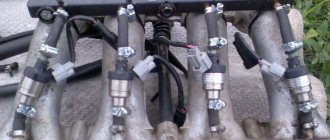Many motorists begin to prepare their car for the winter season ahead of time. Should I buy or make my own thermal case for the battery? Excellent heated battery cases can be purchased in stores. But no matter how much a thermal case costs, a homemade one is better. The owner takes into account the free space and uses under-hood insulation. Protecting the battery from freezing in winter will extend the life of the device and make it easier to start the engine in the morning.
The very idea of a thermal case
Why suddenly, they didn’t insulate it before, but now everyone just rushed in a friendly crowd? If you look at the physics of the process, then this seems to make sense - a cold battery that has been standing in the cold for a day is recharged extremely poorly - that is, its ability to recharge is only 5 - 10%, from a 100% warm battery - in simple words, the battery cannot be recharged in the cold (or you will do it extremely slowly and ineffectively)! After you start the engine, it warms up, and after 5 - 10 minutes (it all depends on the frost) the engine becomes hot, and all nearby elements, including the battery, begin to warm up. The faster the temperature under the hood rises, the faster the battery is charged from the generator, this is a kind of axiom.
It seems like there is a point to a thermal case! It does not allow the battery to cool down and always keeps it warm - THIS IS IN THEORY! But in practice the picture is completely different.
Why do you need a thermal case?
Protection against sub-zero temperatures
At a temperature of -20°C and below, the battery experiences enormous difficulties in ensuring starter operation. Even the use of excellent oil in the engine does not ensure reliable engine starting.
It is important to understand that a cold battery does not charge well, and in severe frost there may be problems with normal charging in the car. This is especially true for urban vehicle operation with short journeys and long stops.
Constantly bringing the battery into a warm room while parked is troublesome and unsafe. Without a battery, alarm systems do not work and the car becomes easy prey for car thieves or thieves.
Numerous tests and experiments in real conditions of severe winter convincingly prove that a thermal case is an irreplaceable, simple and inexpensive solution for saving battery heat, but subject to certain conditions, which will be discussed below.
overheat protection
And you need a thermal case not only to protect the battery from frost, but also from heat.
When the battery is in the engine compartment, the part that faces the engine heats up more than the opposite part. Because of this, heated banks are charged better, while colder ones are undercharged.
Some craftsmen try to make thermal cases with their own hands, using various types of insulation, reflectors, etc. But often such “works of art” turn out unsuccessful.
Incorrect thermal case
Let's put aside all prejudices and think - is this necessary for our battery? I will analyze two situations that were collected from a large number of reviews:
- If we imagine a warm battery that was kept warm in our house, and we carry it “warm” into the car in a thermal case - then yes, it will not cool down for a long time and will start charging perfectly after starting! That is, there is a point to such a thermal fur coat. But it's not that simple.
- As a rule, your batteries sit in the cold all day long (and at night the frosts only get worse). The battery will, willy-nilly, cool down, even freeze a little! So you come in the morning - you start your car - the battery must give a certain current and then begin to take it from the generator (and as we know, it practically does not take it when it is cold) - so, your engine warms up, but the battery does not warm up, that is, it frozen, and the cold does not leave the thermal case, just as the heat (from the engine) cannot pass inside! The result is a “snowman” effect - if in warm weather you put a down jacket on a snowman, then it will melt more slowly than the rest. After all, the cold inside will remain like in a thermos.
That is, your thermal case will keep the cold inside the battery in the morning, and not warm it!
Now imagine, you arrived at work (let’s say 20 minutes from your home), the battery still didn’t warm up - it didn’t recharge (properly). In the evening, it’s commonplace, when leaving work, you may not start the engine! Watch a short video for understanding.
Thermal case for battery - owner reviews
Heated thermal cases can not only serve in cold weather, they will also protect the battery from overheating in hot weather. This ability was appreciated by many drivers. We present typical reviews of the thermal case for heated batteries.
Arkady recommends getting a protective shell for everyone who has an automatic start; the car runs for less than an hour a day. In such conditions, the battery does not have time to recharge. Heating helps.
Alexander from Novosibirsk was skeptical about the new product he had purchased, until one day he forgot to turn on autostart in the evening. The frost was -30 0, the interior was frozen, and not expecting anything good, he turned the key in the ignition. The car started on the first try. That’s when Alexander rated the thermal case for the battery and wrote a review.
Valentin from Ufa said that thermal plates do not operate on a battery; they heat up the body even when the motor starts running. He considers this a good thing, since the capacity of the heated battery increases. He also considers the thermal case unnecessary, since during long periods of inactivity it does not relieve the battery from deep cooling.
The right thermal case
Now I want to protect these “miracle fur coats” a little, but there is still a point in this. But you need to do everything right. Now they sell in two directions:
- Just a thermal cover
- Heated thermal case - low-voltage plates are built into it, which, in principle, provide heat inside, which this thermal case holds like a thermos.
It is the second type that exists in winter, and it is this that you need to use on your cars. Here, the heating elements heat up the battery, it becomes warm and accepts a charge perfectly after starting the engine. This is the ONLY way a battery case should be .
Which thermal case to buy
When purchasing such a thermal case for a battery, you should pay attention to some nuances:
- where the battery is attached, there should be a margin of about 1-1.5 centimeters on each side;
- before purchasing, measure the battery parameters - length, width, height (and measure the height with the terminals);
- specify which battery case is European, Asian or American;
- do not forget about the difference in diameter and placement of terminals;
- the plates should not be longer than the battery;
- take a case that matches the battery size and mounting type.
In its manufacture, high-quality materials are used that are resistant to moisture, acids, and heat. Thanks to this, the thermal case has no expiration dates.
Heating elements
Now many can - but where can they get these elements and how much energy do they take? Everything is also simple here - usually if you buy a thermal case, you will definitely be offered a heating system for it - YOU NEED TO TAKE IT!
These are plates - which are made either of plastic or of very thin textolite, with built-in heating elements. Usually there are only two of them and they are installed on the larger sides of the battery. Energy consumption is very low, from 20 to 40 W.
The consumption of the heating plates is very small, on average for two plates, which are located on the sides of the battery - 30 W.
You can compare it with heating the rear window of a car , so about 20 - 30 W, of course, they will not heat your battery “red hot”, but they will not allow you to cool down to minus values, the battery will be warm, which is “just right” for it.
What are the disadvantages:
- As a rule, the elements are powered directly from the battery, but you can turn them on only when needed, for example before starting or after starting the car engine.
- If left overnight, it can drain your battery.
- Many motorists carry with them additional small batteries, precisely to warm up the main battery, for example from “uninterruptible” batteries - this is complicated by the fact that you need to carry a battery with you, even if it’s small, but it’s still inconvenient. At home after starting it is necessary to recharge, otherwise it will run out.
Installing a thermal case on a car
The size of the thermal case depends on the size of the battery. European traditions of engine compartment layout differ from Japanese ones. In most Japanese cars, especially those of the late 20th - early 21st centuries, the layout is simpler and the thermal case is installed without problems.
Thermal cases for small batteries (passenger cars)
Using this table, you can select not only the dimensions of the thermal case depending on the capacity and battery case, but also determine the approximate cost.
There is nothing complicated when installing a thermal case on domestic cars, such as early classics. The battery is placed in a case, heating plates are inserted along the long sides. The unit with the thermostat is placed in a case along one of the short sides of the battery.
The thermal case is fixed in its regular place and connected with cables to the on-board network. The thermal relay wires are attached between the battery terminals and the mounting nuts.
After installing all the wires, you must carefully check the tightness of the terminals.
The lid is attached to the top of the thermal case with Velcro.
You can buy the thermal case separately or in a set with heating plates and other additional elements.
The manufacturer advertises the following positive properties of thermal cases:
- — protection of the battery from mechanical impact, dirt and dust;
- — protection from exposure to aggressive environments (electrolyte, brake fluid, gasoline, antifreeze, fire, etc.);
- — providing protection against thermal shocks (hypothermia and overheating) during the entire period of operation of the car battery;
- — slowing down the cooling time of the battery for the period when the heating plates are turned off;
- — heating the battery to a positive temperature before starting the engine.
How to make it yourself
If you are wondering about a thermal case with your own hands, then making one is not that difficult. Many people use penofol as the main heat-insulating element. This is foamed polyethylene with a reflective surface.
One layer will not be enough, so first you should wrap the battery with the first layer with the shiny surface inward, then the second outer layer, on the contrary, with the shiny surface outward. In this way we imitate the effect of a thermos, the temperature will slowly penetrate inside and also come out. The top and bottom of the battery are made the same - the bottom and the cover, special holes are cut for the terminals. Ponofol can be secured with special construction tape.
Watch this useful video.
This is where I will end my article – review. Make a thermal case wisely, otherwise it will only cause trouble. Read our AUTOBLOG.
Similar news
- How to lubricate battery terminals to prevent oxidation? Plus video
- How to charge a calcium battery. Correct instructions for a...
- TOP5 – Russian batteries. My rating
Add a comment Cancel reply
How to use a thermal case correctly
Before using the thermal case, place the battery in it:
- Place a special heat-protective gasket on the bottom of the case.
- Place the battery in the case and replace it.
- Connect the terminals, close the lid of the thermos so that there are no gaps.
- Secure the battery using fasteners.
NTA should be turned on when the engine is running. There is no need for any supervision over him.
The device begins to heat up only at reduced temperatures in the thermos – from +5°C to 0°C. When the temperature inside the thermos rises to +25°C, and even with the engine turned off, the heating of the device stops.
There is no need to dismantle the NTA for the summer.
Thermal case with heating plates
But simple thermal cases had one significant drawback. The fact is that their low heat loss played a cruel joke on them. During the night, the batteries in the thermal box outside managed to freeze significantly. And in the morning they did not heat up, since the case, like a thermos, retains heat and cold equally well.
That is why the idea came to make battery cases with built-in heating plates. They allow you to quickly achieve the optimal temperature for fully charging the battery.
Heating occurs only up to 26 degrees and then stops. The heating action resumes when the temperature drops below -5. Thus, the thermobox will constantly maintain the same temperature for a long time.
Table: types of thermal bags for batteries
| Name | Device Features | Operating principle | Advantages | Flaws |
| Thermal case without heating | Thermos of multilayer seamless design, consisting of: |
- covers;
- housings;
- bottom insert;
- additional fastening belts.
- lid;
- frame;
- bottom insert;
- additional fastening straps;
- heating components installed inside the case and designed to protect against negative temperatures, while simultaneously heating the battery when the power unit is running;
- electronic control module;
- wires.
Installation and use of the thermal case
Briefly about installing and using the thermal case:
- The vehicle battery is packaged together with heating components in an insulating case.
- The contacts are being connected. The thermal case is powered by a rechargeable battery, so the wires of the device must be connected to the terminal outputs of the battery, taking into account the polarity.
- The device is being installed.
- When the power unit is started, the heating components begin to function. Their action continues until the device warms up the battery to 25 degrees Celsius.
- When the engine is stopped, the heating components of the battery stop working. Thanks to the insulating casing, the heat of the battery is retained for several hours.
Video: use and nuances of operating a thermal case
The “Battery Man” channel talks in detail about the use of a thermal case and provides an overview of this device.
To buy or not to buy a thermal case
Such a device, or simply a battery case, is not considered universal for solving the listed problems. And it is impossible to give an exact answer whether to purchase such a device or not. Also, you should not try to replace the thermal case with a similar one you made yourself with heating.
The fact is that using a thermobox in mild winters, when the temperature practically never drops below -20, is practically useless. It can be purchased for abnormally hot summers and very cold winters. For mild climates with moderate sun, the device will be useless.
Also, despite the fact that the case also protects the battery from shock and dirt, it still remains not in great demand. Purchasing it only for these functions is pointless and expensive. In addition, it is recommended not to purchase a thermal box without heating elements. The simple case with no heating function makes it a simple bag made of quality material.
But at the same time, in order to increase the service life of the battery, it is necessary to create good operating conditions. The main thing is to protect the battery from thermal shocks, which greatly affect the quality of its operation.
It is generally accepted that car batteries do not like subzero temperatures. But this is wrong, in fact, all the damage is caused during operation in the heat, and in the cold they manifest themselves sharply.
The thermobox for batteries helps well both in weather with sub-zero temperatures and in hot summers.
The principle of operation of a thermal case - thermos
Usually it takes about an hour to completely warm up the engine, only after that the battery begins to charge as it has warmed up. But if it is cold, it does not have time to charge normally, and when parked it does not have time to replenish the charge.
A thermal cover for a car battery was invented just to keep the battery warm. It works like a thermos for batteries. It's just a case with reflective materials on the walls. And it turns out that the thermal case prevents the heat from escaping and the cold from entering inside.
Izolon is used to sew such a battery case. Its heat loss is 0.7 degrees per hour. This is quite enough to prevent the battery from freezing after inserting it into the car.











